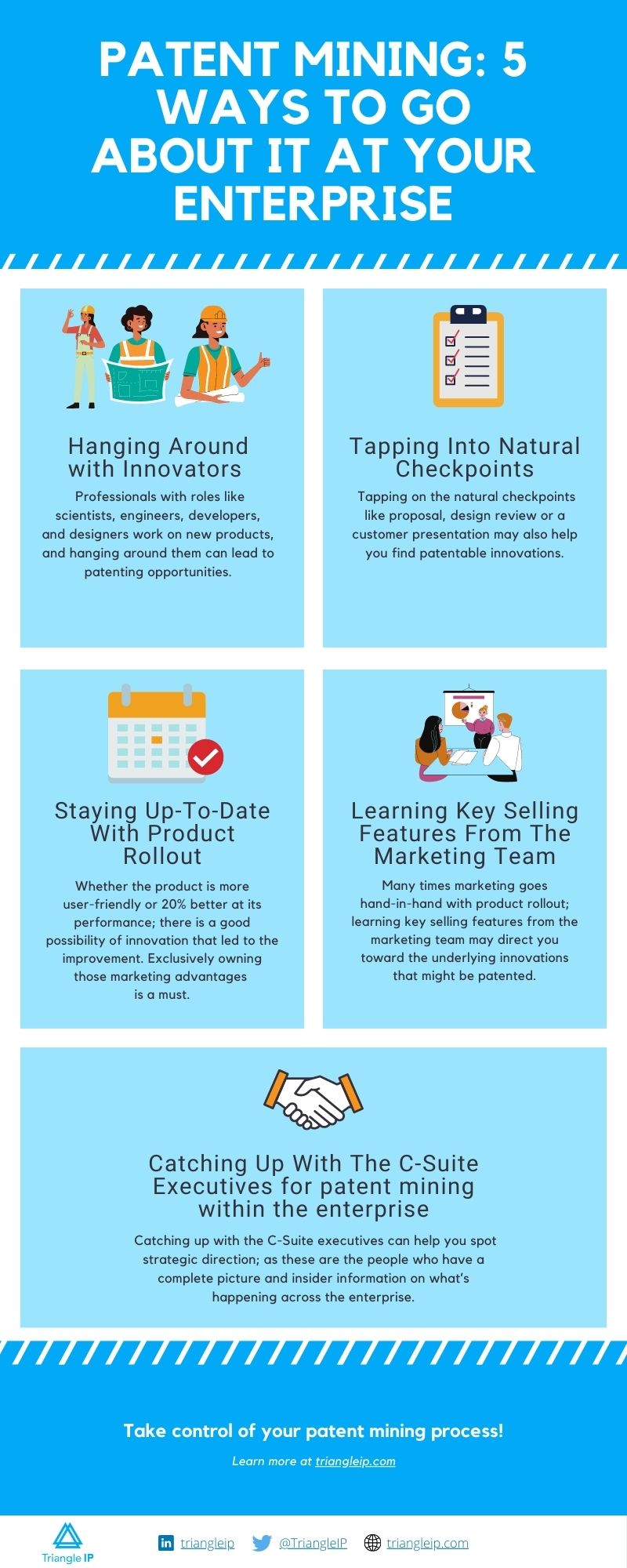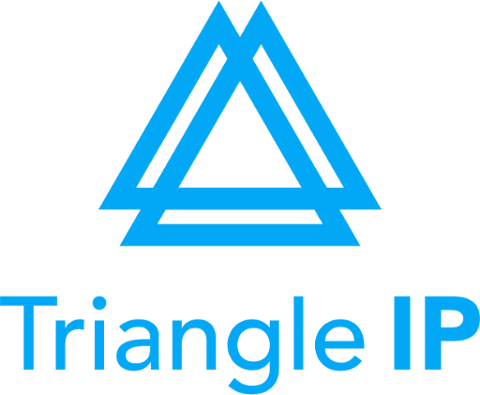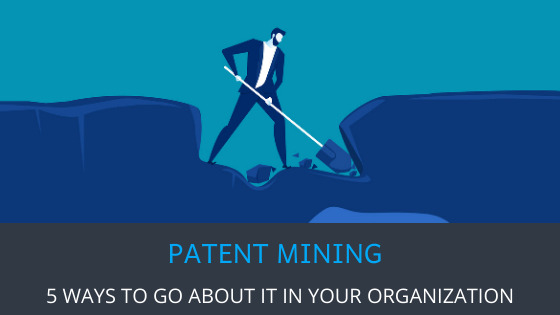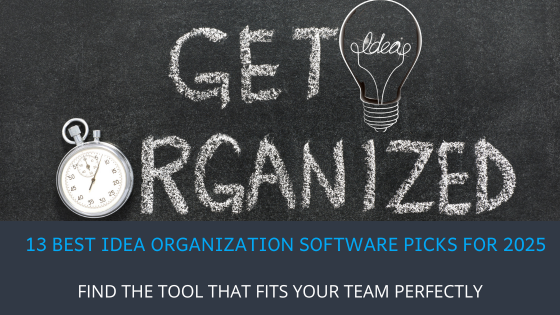As a patent portfolio manager, you want to keep abreast of innovations within the enterprise.
You want to detect and capture likely patentable innovation early enough.
It’s you, who best understands the importance of creating valuable IP.
Maybe you are super technical or maybe not.
You may be comfortable in one technology domain but may not understand other technology domains so well. However, you need to capture innovations from all product lines in the enterprise.
This process of patent mining can be challenging in the absence of a systematic approach.
“Patent Mining is like a treasure hunt, the key to the treasure lies in asking the right questions to the right people.”

The right people being:
- Developers
- Engineers
- Scientists
- Product Designers
- Marketing
- C-suite
And the right questions frame the patentable aspects of innovations across the enterprise. Ready to dive in? Here are the 5 ways you, the patent portfolio manager, would go about mining for patents at the enterprise.
Hanging around innovators
Tapping into existing development checkpoints
Staying up-to-date with product rollout plans
Learning key selling features from the marketing team
Knowing the strategic vision from the C-Suite executives
Hanging Around with Innovators for Patent Mining
Having the smartest employees is wasted if there is no opportunity to uncover their inventive ideas. Hang around people within the enterprise who have titles such as developers, engineers, scientists, and product designers. Find out about the problems they are solving and the technology they are developing to do so. The company presumably hired these sorts of employees to build new things so certainly they are coming up with new ideas as they carry out their work.

Networking with these groups of technical people will lead to discussions about their work and patenting opportunities.
Tapping Into Natural Checkpoints
Product development is multifaceted. The process has many stages from conceptualization through market release with the process varying in every enterprise. Usually, during the product development process, you have natural checkpoints that you should look out for. For example, during the product development stage, you might have a proposal, design review or customer presentation. These are often opportunities to get insights so lookout for things that could be patented.

Ask questions about the uniqueness or novelty of the product being developed or its advantages. Focus on the responses and get feedback about the products satisfaction of customer needs. The feedback received would often expose a path to new improvements or enhancements that can place you at an advantage over your competitors. Feedback during the product development process identifies inventive ideas which can lead to a patent.

Staying Up-To-Date With Product Rollout
Closely watch as products get ready for rollout. Product rollout is a term used for the introduction and integration of a new product or service to the market. It is important that you listen to people talking about products that are about to be released. The key questions to ask here will be:
Is there anything new?
What is the problem that this product solves?
What are the advantages of the product?
How is it better than the previous version?
Does the new product make use of new technology?

Asking these questions can lead you to terrific new insights and you shall be able to spot some potential patenting opportunities. Timeliness is of the utmost importance here. In the U.S. you lose the right to file a patent after one year of disclosing any information about the new product to the public. Marketing often controls the release of product information to create filing deadlines.
Learning Key Selling Features From The Marketing Team
Marketing usually goes hand in hand with the process of new product rollout. It is crucial that you look out for the key selling features that the marketing team is using to sell the new product. For example, the marketing team can claim the new product is more user friendly than previous products of its type or that it is 20% faster than the previous product. Uncover the technology or innovation associated that is creating that difference, and that might be something to file a patent on.

Catching Up With The C-Suite Executives for patent mining within the enterprise
Networking with key executives on the technical staff, for example, the Chief Technical Officers, Chief Scientists, etc. is key for patent mining within the enterprise. These technical executives usually have a good grip on the strategic vision. They might not be familiar with how patents work so it’s important that you educate them. These key managers usually have their tentacles going in different product directions because they engage firsthand with the technologies used in the enterprise daily. The key managers should be trained to look out for and identify innovations or ideas that can be patented within the enterprise. It is important to catch up with these executives on a regular basis to know their innovative direction.

On a side note: Would you want to know how your patent application is progressing at the USPTO compared to other applications in the same domain?
The TIP tool offers statistics of the law firm and the examiner handling your case. Once the application is filed at the USPTO, and an examiner is allotted to your case, the tool indicates the relative performance of the law firm handling your case. The statistics revolve around the number of arguments, grant rate, and grant time. The tool also indicates the case health, for instance, it can tell you if a case needs your attention. There is a whole bunch of insights that you can gather from the TIP tool for strategic patent prosecution.
Request insights for any of your cases at the patent office using the form below.
Let’s Sum It Up
These 5 patent mining strategies are the ways to go about gathering up inventions for patent protection. Here is a quick recap of the 5 strategies for you:
- Professionals with roles like scientists, engineers, developers, and designers work on new products, and hanging around them can lead to patenting opportunities.
- Tapping on the natural checkpoints like proposal, design review or a customer presentation may also help you find patentable innovations.
- Whether the product is more user-friendly or 20% better at its performance; there is a good possibility of innovation that led to the improvement. Exclusively owning those marketing advantages is a must.
- Many times marketing goes hand-in-hand with product rollout; learning key selling features from the marketing team may direct you toward the underlying innovations that might be patented.
- Catching up with the C-Suite executives can help you spot strategic direction; as these are the people who have a complete picture and insider information on what’s happening across the enterprise.
Our founder recently talked about patent mining in one of his Youtube sessions. Here is the video:
Hope this would help you break down the sometimes-overwhelming task of identifying patentable ideas within an enterprise. Patent mining is one task and managing the patent capture is a whole different game. In the absence of the right tool, the information might just be a mess, that no one wants to get into. Hence, you might like to explore software that simplifies the process into stages:
Idea Capturing
Internal Vetting
Patent Drafting
Patent Filing
Portfolio Managing

Here is a good guide for you to evaluate the tools for innovation capture for a sound IP strategy.
Here’s our guide on the 7 Best Patent Management Software in 2026 to help you choose the right platform for managing your portfolio.

Note: The preceding is general business advice and not to be construed as legal advice. IP laws vary by country and retaining licensed legal counsel is advised to confirm this information. Any expressed or implied opinions are of the author and do not necessarily reflect the views of Triangle IP or any other entity who might be associated with the presenter. We hope this content is helpful to you, but should not be relied upon without confirming the advice and accuracy with local legal counsel. Any comments or inquiries are not confidential so please discuss your issues directly with counsel.





